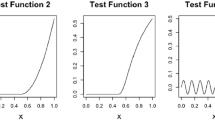A random dose U is injected in a biological organism. Let X be the lower bound, from which response (effect) A random dose U is injected in a biological organism. Let X be the lower bound, from which response (effect) may be registered: if X <U, then effect is registered; otherwise it is absent. Let W be the indicator of event {U > X}. The considered characteristic is a regression of W on U, i.e. conditional mathematical expectation E(W|U = x). If injected random dose U and lower bound X are independent, then E(W|U = x) = F(x), where F(x) is a distribution function of random variable X; hence the estimate of unknown distribution function F(x) may be constructed in the form of kernel regression estimate. If U and X are dependent, then conditional mathematical expectation E(W|U = x) = F(x) = P(X < x|U = x) = F(x|u) = T(x) is a conditional distribution function, which in case of studying toxic substances is called the toxicity function. For independent random variables (U,X) function T (x) = F(x) is monotonically nondecreasing. If U and X are dependent, then T (x) takes values from the interval [0, 1], but may be decreasing for some x. Such toxicity functions are called paradoxical — increasing the dose for some values leads to reduction of the effect. Real toxicity functions are quite often paradoxical: in the beginning, increasing the dose of injected substance leads to a growth in the effect; then with increasing of dose the effect diminishes, and then with further increasing of injected dose the effect grows again. We consider the case of independent random variables and study asymptotic behavior of estimates for F(x), although proposed estimates may also be used for paradoxical case.
Similar content being viewed by others
References
S.V. Krishtopenko and M. S. Tikhov, Toxicometry of Effective Doses, Nizhny Novgorod University Press, Nizhny Novgorod (1997).
S.V. Krishtopenko, M. S. Tikhov, and E.B. Popova, Paradoxical Toxicity, Nizhny Novgorod University Press, Nizhny Novgorod (2001).
C.R. Rao, Linear Statistical Inference and its Applications, John Wiley and Sons, New York (1973).
N.W. Hengartner, “Asymptotic unbiased density estimators”, J. R. Statist. Soc. Ser. B, 59, No. 2 (1997)
E. L. Lehmann, Theory of Point Estimation, Wiley, New York (2003).
M. S. Tikhov, “Statistical estimation on the basis of interval-censored data,” J. Math. Sci., 119, No. 3, 321–335 (2004).
M. S. Tikhov and I.S. Efimenko, “Asymptotic unbiased distribution function estimators on the basis of interval-censored data,” in: Applied Statistics: Program and Abstract, Lubljana, Slovenia (2004) pp. 48–52. http://ablejec.nib.si/as2004/AS2004-abstracts.pdf
Author information
Authors and Affiliations
Corresponding author
Additional information
Translated from Statisticheskie Metody Otsenivaniya i Proverki Gipotez, Vol. 18, pp. 60–72, 2005
Rights and permissions
About this article
Cite this article
Tikhov, M.S., Dolgih, I.S. Asymptotically Unbiased Estimates of a Distribution Function in Dose Effect Relationships. J Math Sci 205, 113–120 (2015). https://doi.org/10.1007/s10958-015-2236-5
Published:
Issue Date:
DOI: https://doi.org/10.1007/s10958-015-2236-5



